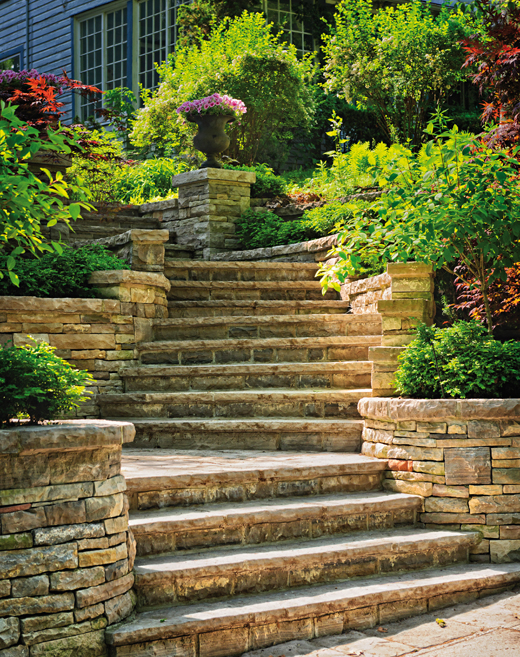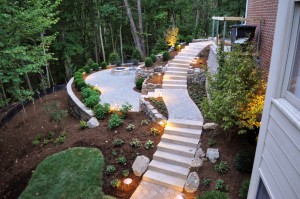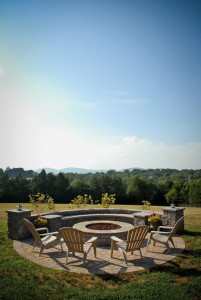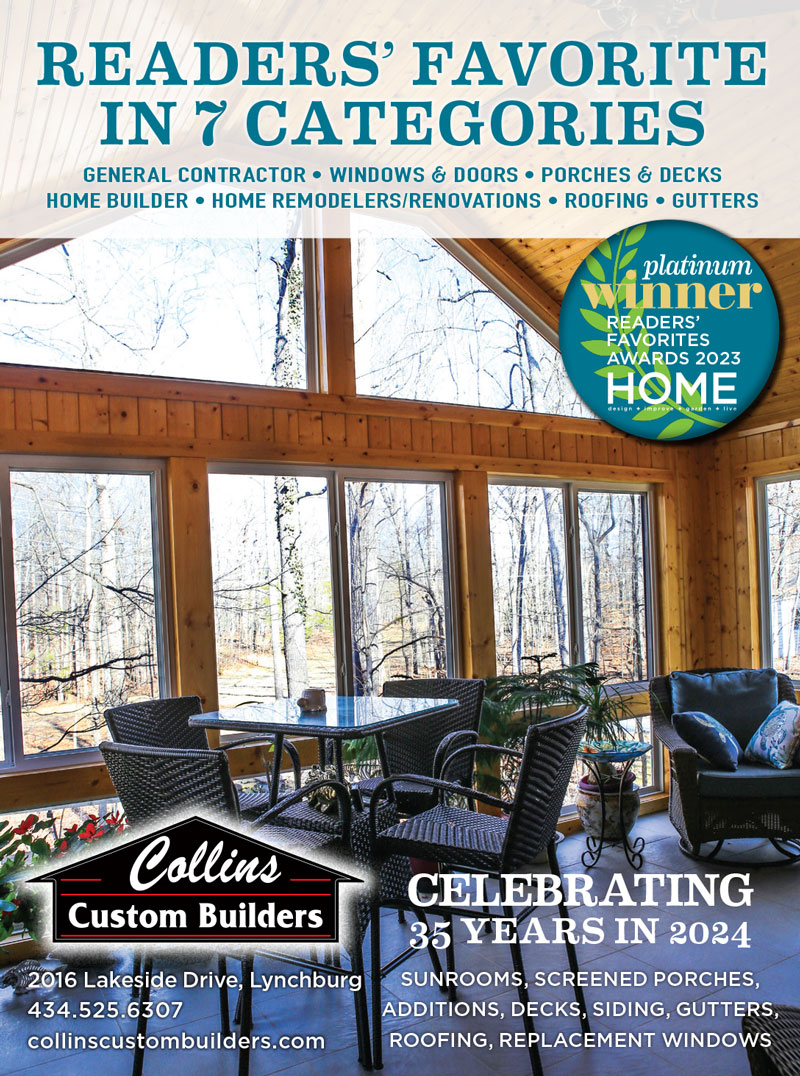Living On The Edge: Softening the Lines Between Hardscapes and Landscapes
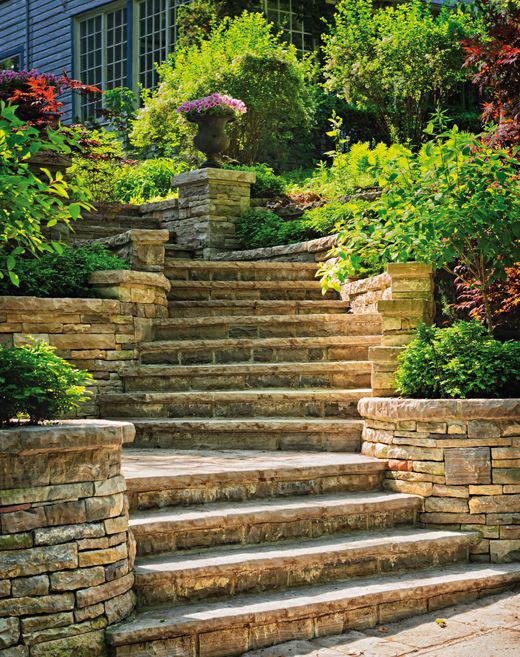
As our yards are returning to their warm-weather glory with the arrival of spring, many of us will be itching to enjoy the outdoor spaces we’ve missed all winter. In recent years, the trend of embracing gardens, patios and lawns as extensions of the home has expanded how people think of and use their yards. With homeowners looking for more ways to develop their yards, features such as decks, fire pits, pools and patios with patio covering have become increasingly common. Though these elements (generally referred to as hardscapes) serve great purposes, they can create visual discord with their hard lines and rigid looks if they are not balanced and buffered with proper landscaping like the one offered by Lanterra Services.
Hardscapes and landscaping are often addressed as separate projects. But by treating these two huge elements as separate entities, you could be limiting your property’s overall aesthetic potential. If you were instead to take a step back and imagine your yard, driveway, garage, porch, patio, deck, sidewalks, pool and everything that surrounds them as an extension of your home, the results could be surprising. Literally softening the edges of your hardscapes by utilizing good landscaping techniques can blur the lines between the two, creating a visual flow and elevating your property to resort-like status.
The Lay of the Land
As with any project, it is important to plan ahead and have a good understanding of the way your structures and yard work with each other and what you hope to accomplish. Maybe your home sits on the side of a hill and you are having problems with erosion control. Perhaps you have rows of shrubbery around your front porch, and all that’s needed is proper pruning to smooth over any rough edges. Or it could be that your driveway appears long and awkward and requires some spicing up to eliminate that “runway” feel. Embrace the natural flow of your land and click here for expert help on how you could work out some of the blockier corners or bare areas.
All Hands on Deck
Some of the more common hardscapes are patios and low-lying decks. When planning for residential or commercial landscaping additions here, start by going out and sitting on your patio or deck and take note of where your gaze is naturally drawn. This should be the focal point of any landscaping work. Keep in mind that your entire yard will be viewed as one large presentation that does not end with the perimeter of your deck or patio structure. For this reason, it is important to hire a landscaping company Richmond to make sure one area flows into the next. This might mean planting colorful border trees and shrubberies all around the exterior of your yard as sort of a backdrop for your presentation. Larger plants such as crepe myrtles, Japanese red maples, redbuds, and dogwoods are wonderful choices that add a variety of color. Evergreens such as junipers and cypresses are also great picks that will provide year-round greenery and make excellent privacy borders.
With the foundational vegetation in place, you can begin layering smaller plants in the foreground and around your hardscapes to relax the look of their rigid lines with lighter, airy foliage. Many herbs will help you achieve a delicate look around your ground-level deck or patio without a lot of maintenance. Look for dill, thyme, Russian sage, lavender and rosemary to provide soft texture (not to mention the added aromatic and culinary benefits!). Another trick to creating a relaxed atmosphere is to avoid a precise pattern in your plant groupings. Intermingling shorter flowering plants and grasses can give your bed a more natural look, and allowing the plants to fill in on their own will mean less weeding down the road. Consider the layout of your particular hardscape and what areas might especially benefit from landscaping. Turn the severe corners where a sidewalk meets a driveway into an eye-pleasing flower grouping with a fluid, curved border. “Try to use low-growing plants like mondo grass or liriope planted right at the edge of the walkway so it grows slightly over the edge. This guarantees a softer look,” says Mark Maslow, owner and president of Southern Landscaping.
For elevated decks, when the structure is at least 4 or 5 feet off the ground, there are a few additional factors to consider. From your perch, you’ll be gazing at a downward angle on your yard and plantings. Again, establish taller plants first, then work your way down to medium and low-lying choices. Consider shrubs that will grow to be bushy and tall enough to fill in the gaping space between the deck and the ground, such as arborvitae for an evergreen choice or hydrangea and rhododendron to provide a bright pop of color.
Don’t hesitate to bring flora onto the deck as well. Container gardening is an easy and low-maintenance way to break up the wood-on-wood monotony of a large deck. “Containers and potted plants and flowers can soften corners, and be used to separate areas,” says Laurice Jennings, owner and founder of Jennings Works. “They also are a great way to add color.” Group several containers of various heights together, or create a terrace effect by placing pots of trailing plants like sweet potato vine, verbena, begonia and nasturtium up a flight of stairs. Under the deck itself, the most practical choice may be stone mulch (with weed cloth beneath to keep undesirable “volunteers” at bay) since the lack of sunlight prevents hearty grass growth. Available in many colors and textures, there is certainly a stone mulch variety available to complement your hardscape. Stone mulch is also very effective at slowing erosion, making it a great choice to incorporate into landscaping for aesthetic and practical reasons.
Slippery Slopes
Our area is known for its hills, and in some spots it would appear as if every single home is built on an angle. Many homeowners struggle with slope retention and erosion. Fortunately there are elegant ways to deal with these hard-to-landscape problem areas, and the results can be beautiful.
Before proceeding with landscaping slopes, you must consider the soil type and how steep a slope you are dealing with. Southern Landscaping’s Maslow says, “There is no better erosion control measure than a living plant.” He suggests that homeowners look for native species to plant on steep slopes, such as Virginia Sweetspire or Summersweet Clethra. Ground covers are also great choices for hillsides, since their root systems will help provide a sturdy “grip” to the soil. “Another huge benefit is that most ground covers offer low maintenance, and over time as they fill in, reduce areas for weeds to grow and reduce the amount of area to mulch as they get larger,” says Jennings of Jennings Works. His choices for ground covers include blue rug juniper, dwarf Japanese garden juniper, coral beauty cotoneaster, big blue lily turf, and Japanese spurge (a type of Pachysandra).
Terracing walls and creating distinctive walkways with the help of asphalt paving contractors to deal with slope provide opportunity for some unique landscaping, which would not be possible on a flat lot. You may also invest in a sealcoating service to protect your new walkways. Forming terraces, which involves removing sections of dirt and inserting retaining walls to create a functional structure, can be difficult as you have to maintain a proper foundation and support for your slope. The Ocala Landscaper American Grounds Service offers residential & commercial landscape maintenance. A common choice for these walls is to apply stucco over a concrete, brick or block base. In addition, stacking smaller walls into tiers or creating a serpentine wall adds visual interest. Combining outdoor stairways with your terraced walls is also a great strategy. You may even decide to include some stepables (plants that tolerate foot traffic) between your stairways and flagstone or paver walkways. Dwarf mondo grass, creeping Jenny, Irish moss and many varieties of mint are all great selections.
Pools
If you’re lucky enough to have a pool, it’s important to address how it fits with the landscaping. A pool area with great landscaping can become a gorgeous, spa-like destination in your own backyard. For the most part, pools can be treated much like other hardscape structures, although there are a couple of things to consider.
“Concern for plantings around a pool should be in regards to plant ‘litter,’” says Tracey Norvelle, landscape architect and pool construction supervisor at the Land Tech Group of Central Virginia. “While we’ve installed planting beds adjacent to pools, it makes more sense to keep them further from the pool and/or not use wood mulch that can blow into the pool. A stone mulch is more likely to stay in place.” A popular and stylish choice here is something called “River Jacks.” These smooth and multi-colored stones are often used for decorative landscaping around waterscapes. Look for the 1-to-3- inch sizes to keep them from blowing away or scattering.
Non-Plant Elements
Good landscaping takes all of these factors into consideration; great landscaping goes beyond selecting the right plants and mulch, however. Consider using non-plant elements in order to elevate your yard to the next level and give it a resort-like status by adding an unexpected statement piece.
If you find yourself craving that “something extra” in your yard but aren’t ready to undertake a big project, look to features that are ready-to-install that you can simply landscape around. Effects such as a small fountain, a grouping of boulders, a garden bench, or a pair of large urns overflowing with flowers can add a lot of character with minimal effort. Take the opportunity to select a piece that reflects your desired overall atmosphere for your yard, whether it’s an oversized lantern for a Zen look, a masculine log bench for a rustic elegance, or a simple yet contemporary water feature for a modern flair. Use mulch or groundcover around the base, then work your way into low-lying plants like phlox and lantana, then on to slightly taller choices such as coleus or hosta to layer in bright greens, working upwards with taller plants like hollyhock and dahlia. Use the plants you already have incorporated into other landscaping to frame this centerpiece and give a dramatic yet unified effect. Do keep in mind that when it comes to statuary and other non-plant elements, too much can definitely give your yard a cluttered look; don’t overdo it!
Putting it all Together
The sky’s the limit when it comes to landscaping around your home. The best-looking homes and yards combine all types of landscaping styles and strategies to fit the natural layout of their spaces. And they also reflect what homeowners really want to get out of their spaces, whether that’s entertaining with barbeque on the patio, spending a day of fun in the sun in the pool, or simply spending a quiet afternoon taking in the beauty of your garden. Keep these principles in mind to create a comfortable and enjoyable space for you and your family.
As per Infantry Landscaping, never think of your landscaping needs as a liability because this is one of the needed thing for a house to be called a home. It makes your house even more eye-catchy. Many will get jealous of what you have, so make out of the best with your landscaping needs as to the budget you also have.
